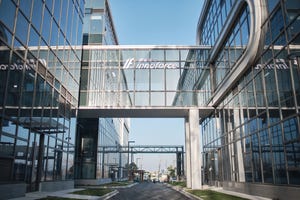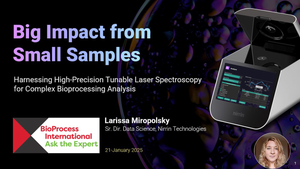
Xcellbio and AmplifyBio partner to advance cell-therapy developmentXcellbio and AmplifyBio partner to advance cell-therapy development
Xcell Bioscience (Xcellbio) says its Avatar platform reduces manufacturing times by up to 30%. We spoke to the company’s chief scientific officer (CSO) to find out more.

Contract development and manufacturing organization (CDMO) AmplifyBio has gained access to Xcellbio’s Avatar Foundry system, enabling small-scale workflows.
The CDMO collaborated with San Francisco-based CGT firm Xcellbio in May 2024, using the latter’s Avatar Odyssey platform for engineered T-cell receptor (TCR) therapies that target solid tumors. The firm seeks to file an investigational new drug (IND) application in the first half of 2025, enabling its therapy to reach clinical trials.
The collaboration will aid the move from small-scale workflows to larger-scale automated cell-therapy manufacturing, enabling development of cell-based potency assays that better predict in vivo effectiveness and generate IND enabling datasets for human papillomavirus (HPV) TCR candidates.
The financials of the partnership were not disclosed.
The Avatar platform includes a family of instruments (Avatar Odyssey, Avatar Ai, and Avatar Foundry) designed to aid the manufacture of cell-therapy products and predict their potency. The three instruments share a hyperbaric incubation technology that can recreate various in vivo microenvironments, including the tumor microenvironment.
The Avatar Odyssey is designed for preclinical research. It was used by Xcellbio to optimize TCR manufacturing with Amplifybio. The installation of the Avatar Foundry will enable the team to manufacture potent and persistent TCR products at a clinical scale, the firm said.
BioProcess Insider spoke to James Lim, CSO at Xcell Biosciences to find out more about the partnership, the Avatar platform, and cell-therapy manufacturing.
BioProcess Insider (BPI): What were the key drivers behind the expanded collaboration between Xcellbio and AmplifyBio?
James Lim (JL): Scientists from both Amplifybio and Xcellbio have been conducting IND enabling studies comparing conventional TCR manufacturing against an Avatar platform-based workflow. We have conducted cell-based potency assays demonstrating that the Avatar platform can enhance the potency and persistence of the product utilizing small-scale workflows. The next phase of collaboration will demonstrate that engineered TCR therapies, when manufactured correctly, can at clinical scale achieve the potency and persistence profiles needed to overcome the immunosuppressive solid tumor microenvironment. Cell-therapy approvals for the treatment of solid tumors have been lacking, to date, cell therapies have not demonstrated the efficacy as observed for blood-based cancers.
BPI: What are the projected impacts of Xcellbio’s Avatar platform on clinical-scale manufacturing workflows?
JL: The Avatar Foundry can significantly reduce manufacturing times by generating significantly more potent cells, thus negating the need for higher cell doses. It is simple to use, requiring little to no training to operate. Automated liquid handling, sampling, and cell harvesting capabilities eliminate key manufacturing bottlenecks, reducing labor-intensive and time-consuming tasks. The system is designed to be compatible with various upstream and downstream process workflows.
BPI: How does the Avatar platform's technology differ from other solutions currently available in the market for cell and gene therapy manufacturing?
JL: It is the only technology that can significantly enhance the potency of cell therapy products. We have demonstrated this through a series of ex vivo and in vivo studies, demonstrating improved potency and persistence of products.
[It also] is simple to use and integrate into existing and new manufacturing workflows. We automated the most labor-intensive and time-consuming steps, from feeding, sampling, and cell harvesting to ensure that product fidelity is maintained through a robust and reproducible workflow.
BPI: Are there any expected financial incentives, cost savings, or potential funding grants related to the use of the system for advancing cell therapy manufacturing?
JL: The Avatar Foundry is currently in beta, and we’ll be positioning the system to become a price leader for both the manufacturing instrument and consumables. In addition to our competitive pricing strategy, the incorporation of the Foundry can drive manufacturing costs down by shortening manufacturing times. Our platform has consistently demonstrated higher yields of transduced or edited cells, shaving manufacturing times by 20 to 30%.
Operational costs are also lower, and our scalable consumable and liquating handling modules are completely automated, thus requiring less labor-intensive and time-consuming steps while minimizing the use of GMP-grade culturing media and reagents.
BPI: Can you provide a timeline of the key milestones achieved so far in the partnership?
JL: We've completed a series of manufacturing optimization and characterization studies. Engineered TCRs manufactured using the platform demonstrated superior potency at effector to target ratios as low as 1:50. Next-generation sequencing (NGS) revealed upregulation of Interleukin-2 (IL-2), Interferon gamma (IFNg), and Tumor necrosis factor alpha (TNF-α).
The first set of animal studies were recently completed, demonstrating that the Avatar expanded TCR-T cells were able to reduce tumor progression. Engineered TCR therapies manufactured in Avatar demonstrated enhanced metabolic fitness by exhibiting increased glycolytic activity while maintaining high oxygen consumption.
BPI: What are the major hurdles AmplifyBio and Xcellbio foresee in moving from small-scale workflows to automated, clinical-scale manufacturing? How do they plan to address these challenges?
JL: The major challenge for cell-therapy developers is the translatability from small-scale to clinical scale manufacturing. The initial manufacturing processes developed during the preclinical phase tend to be a manual and labor-intensive process, and as such product quality and overall yields can vary widely from technician to technician and from manufacturing-site to site. The reagents, culture media, culturing vessels, and instruments used to initially develop a small-scale manufacturing workflow often struggle to translate in a clinical setting, both from a compatibility and cost perspective.
About the Author
You May Also Like







